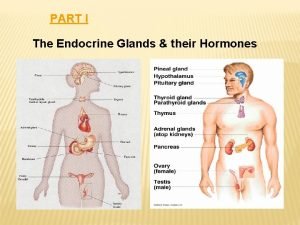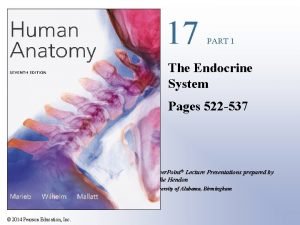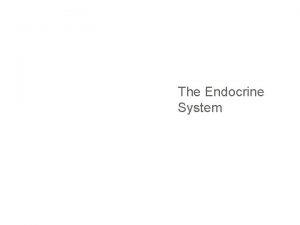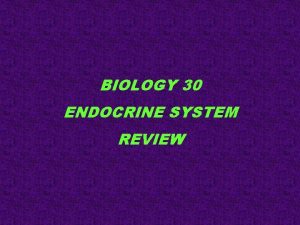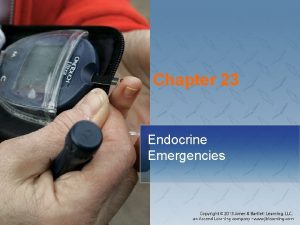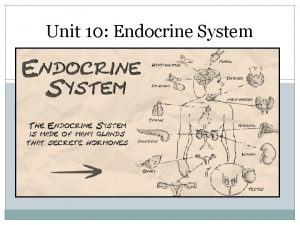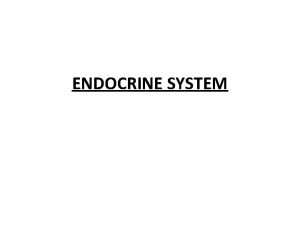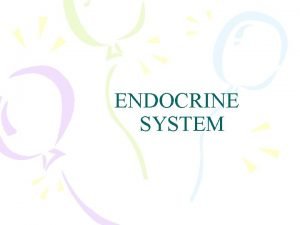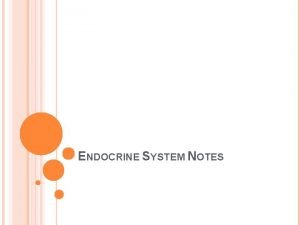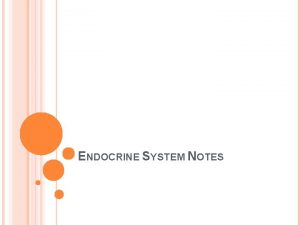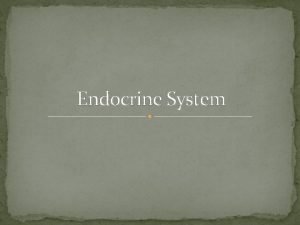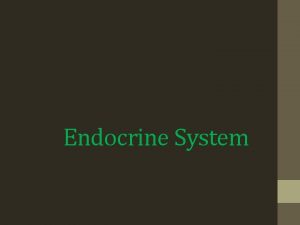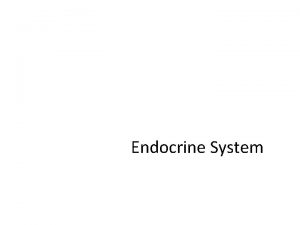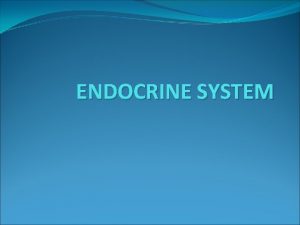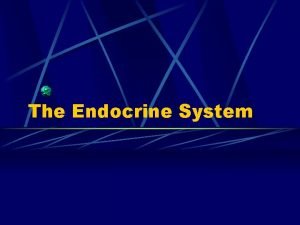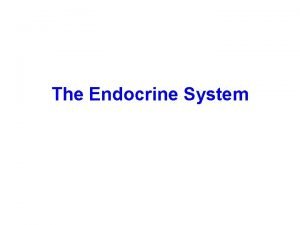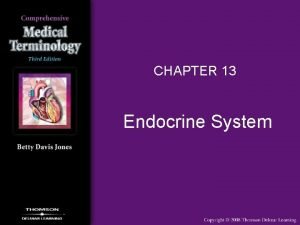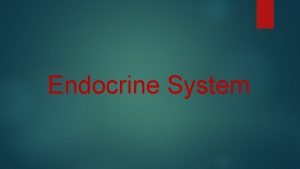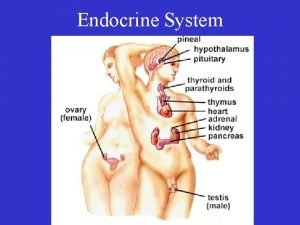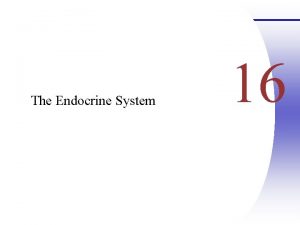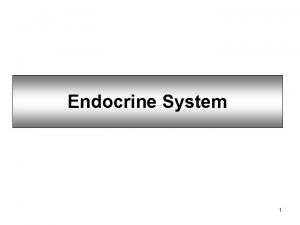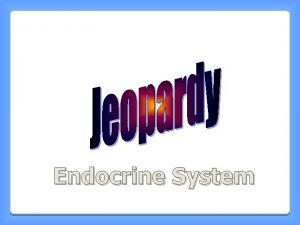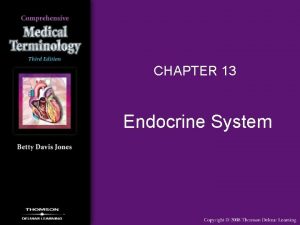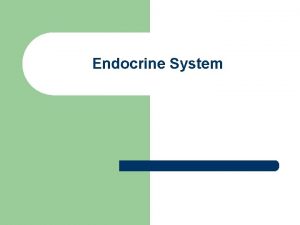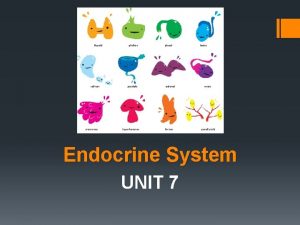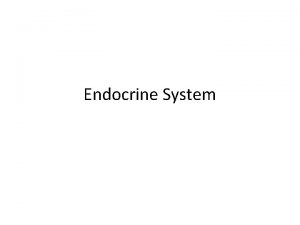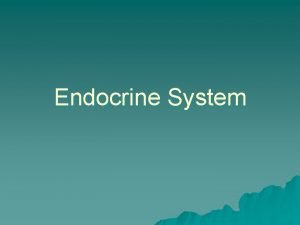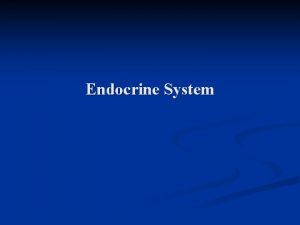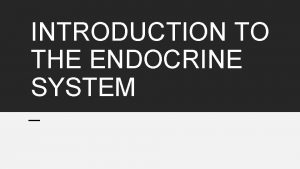ENDOCRINE SYSTEM NOTES THE ENDOCRINE SYSTEM pp 997



























- Slides: 27

ENDOCRINE SYSTEM NOTES

THE ENDOCRINE SYSTEM (pp. 997 - 1008) There are two systems that regulate the body. The nervous system relays information to the body Electrical system using ______________ that fast travel very _______, but the messages are shortlived. The endocrine system uses hormones chemicals _________, or _________ blood messages that travel through the _____ to relay information to the body. .

THE ENDOCRINE SYSTEM The endocrine system is slower-acting, but the Longer lasting action of hormones is ____________. hypothalamus The __________, which maintains homeostasis in the body, controls most of the glands of the endocrine system.


I. ENDOCRINE GLAND FUNCTION A. Hormone Production Hormones help regulate growth, metabolism, appearance, behavior, growth, reproduction, and fluid balance. Most hormones are produced endocrine by ________ glands.

ENDOCRINE GLAND FUNCTION Endocrine glands are unique because they are ductless; in other words, hormones are secreted the blood into __________ and the circulatory ___________ system transports the hormone to its destination. Its destination is known target as its _______. A hormone may have only one target, or it may have several.

ENDOCRINE GLAND FUNCTION B. Control of Hormone Production Hormone release is regulated by a mechanism Negative feedback known as ______________. Information about the effect of the hormone is “fed back” to the gland. When the desired condition is reached, the gland Switches off ____________________

NEGATIVE FEEDBACK SYSTEM

TYPES OF HORMONES C. Types of Hormones – Hormones can be placed in two groups based on chemical structure: 1. Peptide hormones – Most hormones are composed of _________ and are proteins known as peptide hormones. 2. Steroids – _______ molecules derived Lipid from ___________. Include the sex hormones cholesterol testosterone & estrogen ________________


HORMONE Growth Hormone Thyroxine GLAND EFFECT Stimulates _mitosis_; undersecretion results in Pituitary _dwarfism__; oversecretion results in Gland _gigantism_ Thyroid Regulates __metabolism____; requires _iodine___ for normal function

HORMONE Insulin Glucagon GLAND EFFECT _Lowers____ blood _glucose___ concentration by Pancreas stimulating cells to take up glucose; triggers storage of glucose as _glycogen______; not produced in individuals with _Type I Diabetes_____ __Increases______ blood glucose concentration by Pancreas breaking down _glycogen_______ stored in liver to glucose

Epinephrine Adrenal (_Adrenaline_) Glands Known as _”fight or flight”____ hormone _Bronchioles___ dilate to increase air flow for _cellular respiration_____ _Glycogen_____ in the liver is broken down to glucose for _cellular respiration____ _Heart___ rate is increased Blood flow to the _skeletal__ muscles increases Blood flow to the _digestive____ system is decreased

Testosterone Estrogen/Proge sterone Testes Ovaries Triggers development of secondary sex characteristics; _meiosis_____ to produce __haploid____ sperm cells. Triggers development of secondary sex characteristics; __meiosis______ to produce __haploid_____ egg cells.

REPRODUCTIVE SYSTEM

FUNCTION: The purpose of the reproductive system is to produce _gametes_ and allow for _fertilization_ to take place. Although a healthy reproductive system is not a requirement for an individual _organism, it is essential for continuation of a _species.

MALE REPRODUCTIVE SYSTEM Scrotum – Contains testes; allows for _lower temperature needed for sperm production Testes – Site of _gamete_ production. Specialized _diploid (2 n) cells undergo _meiosis_ to produce _haploid (n) sperm cells. Meiosis begins at _puberty and continues until _death Each meiotic division produces 4 sperm cells with 23 chromosomes

Epididymis- sperm mature & are stored Vas Deferens – Tubes that transport sperm to _urethra. Glands � Prostate Gland Seminal Vesicles – Produce _semen to provide _nutrients, protect sperm from acidic vagina � Bulbourethral Gland – Produces acid neutralizer to protect sperm from any residual _urine_____ in urethra Penis – Means for sperm delivery via _urethra during _ejaculation_

FEMALE REPRODUCTIVE SYSTEM The female reproductive system is designed for _gamete production and development of the _embryo_ following fertilization.

FEMALE REPRODUCTIVE SYSTEM Ovary – Site of meiosis and gamete production; however there are three ways oogenesis differs from spermatogenesis: � Meiosis begins _before birth, but it is paused until puberty so females are born with total set of immature egg cells. During the female menstrual cycle, one egg cell or _ovum__ completes meiosis. � Meiosis stops when a female is 45 -55 years old. Known as _menopause; menstruation ceases � Meiosis produces only _one_ egg cell. The other 3 cells disintegrate so that the single egg cell contains all the _cytoplasm.

FEMALE REPRODUCTIVE SYSTEM Oviducts – Also known as the _fallopian tubes____. Passageway for egg cell during ovulation. Site of _fertilization__. When sperm and egg cell fuse, a _diploid____ _zygote___ is created with _46__ chromosomes. Development of the zygote to an _embryo____ → _fetus____ → _baby__ is carried out through _mitosis


FEMALE REPRODUCTIVE SYSTEM Uterus – Site of _embryo development. � Implantation takes place approximately 5 -7 days following fertilization. � If fertilization does not occur, lining of uterus is sloughed off during _menstruation____. Vagina – Also known as “_birth canal”; passageway for _sperm_ in and _baby_ out




 Hasil dari cos 450° + sin (-225°)
Hasil dari cos 450° + sin (-225°) Partes de un andamio metalico
Partes de un andamio metalico Endocrine system and reproductive system
Endocrine system and reproductive system Endocrine system vs nervous system
Endocrine system vs nervous system Lymphatic system vs endocrine system
Lymphatic system vs endocrine system Endocrine vs nervous system venn diagram
Endocrine vs nervous system venn diagram Endocrine system and nervous system
Endocrine system and nervous system Wisc
Wisc Chapter 16 matching question 6-10
Chapter 16 matching question 6-10 Parts of the endocrine system
Parts of the endocrine system Differences between nervous system and endocrine
Differences between nervous system and endocrine Comparison of endocrine and nervous system
Comparison of endocrine and nervous system Steroids endocrine system
Steroids endocrine system Facts about the endocrine system
Facts about the endocrine system Endocrine glands of rat
Endocrine glands of rat A hormone
A hormone Pearson
Pearson Are endocrine glands ductless
Are endocrine glands ductless Chapter 7:13 endocrine system
Chapter 7:13 endocrine system Mammillary body
Mammillary body Figure of endocrine system
Figure of endocrine system Chapter 11 endocrine system
Chapter 11 endocrine system Biology 30 endocrine system
Biology 30 endocrine system Gonads glands
Gonads glands Pituitary
Pituitary Endocrine system analogy
Endocrine system analogy The endocrine system consists of
The endocrine system consists of Endocrine system abbreviations
Endocrine system abbreviations









